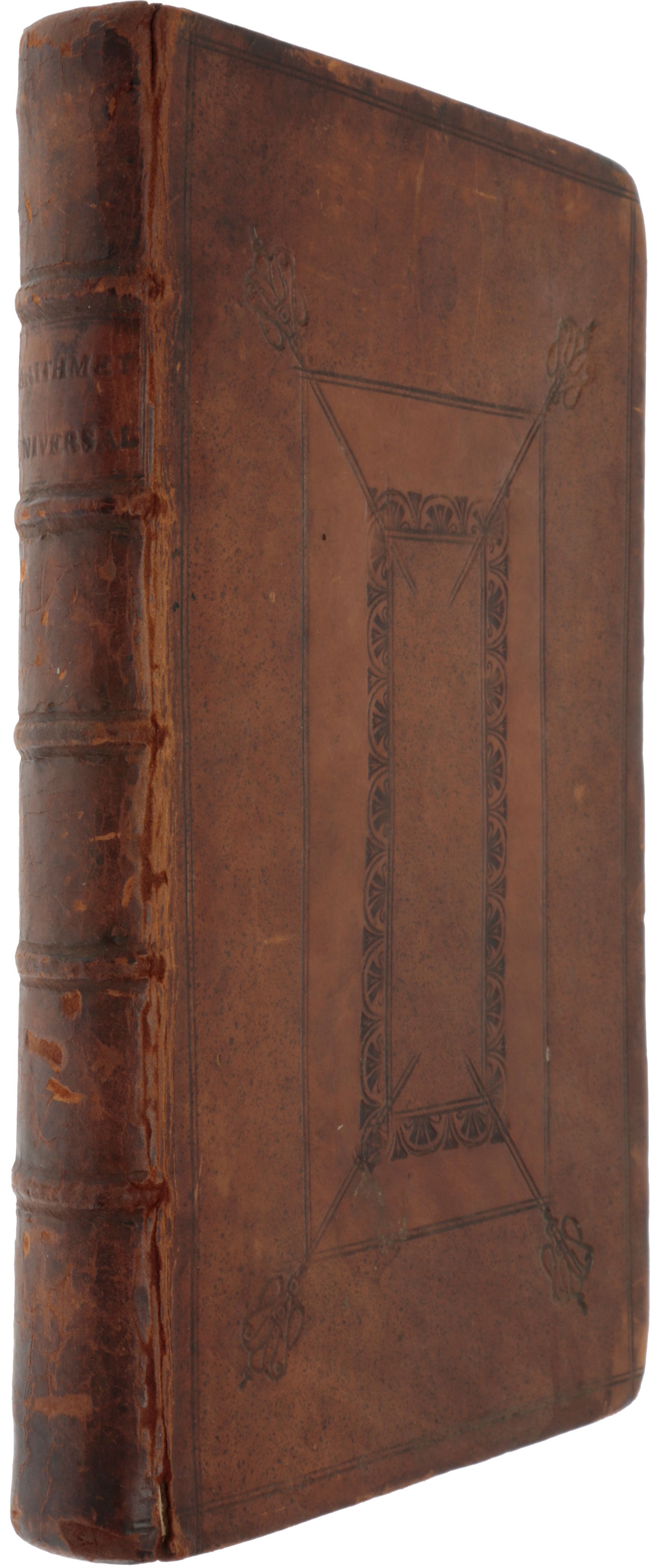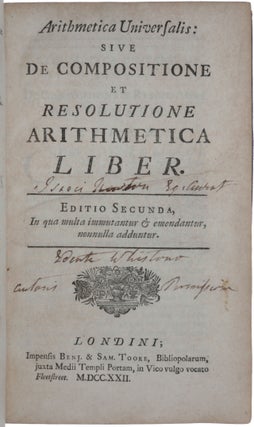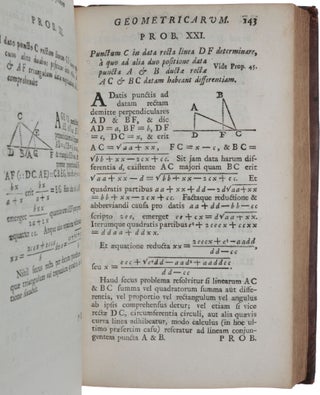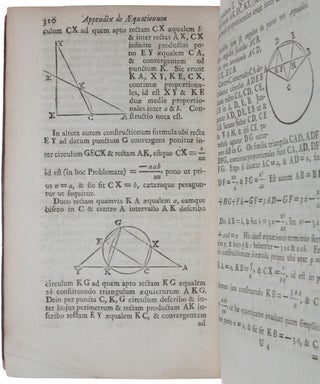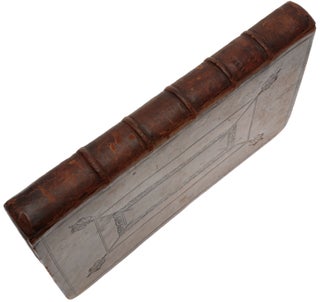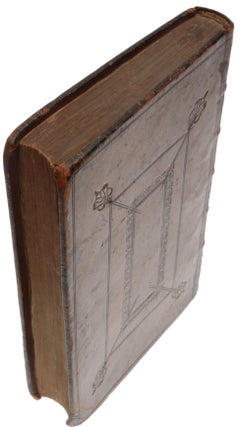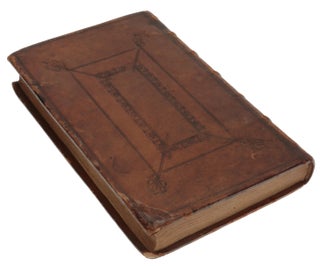Arithmetica Universalis; sive de Compositione et Resolutione Arithmetica Liber. Ciu accessit Helleiana Aequationum Radices Arithmetice Inveniendi Methodus ...
London: Benji & Sam. Tooke, 1722. Second edition, but the first authorised and edited by Newton (probably with the assistance of John Machin – see below), of his treatise on algebra, or ‘universal arithmetic,’ his “most often read and republished mathematical work” (Whiteside, Papers V, p. xiv). “Included are ‘Newton’s identities’ providing expressions for the sums of the ith powers of the roots of any polynomial equation, for any integer i [pp. 251-2], plus a rule providing an upper bound for the positive roots of a polynomial, and a generalization, to imaginary roots, of René Descartes’ Rule of Signs [pp. 242-5]” (Parkinson, p. 138). About this last rule for determining the number of imaginary roots of a polynomial (which Newton offered without proof), Gjertsen (p. 35) notes: “Some idea of its originality … can be gathered from the fact that it was not until 1865 that the rule was derived in a rigorous manner by James Sylvester.” The work is a printed version of lectures Newton prepared in the period 1672-83. Although the editor of the first edition, William Whiston, later claimed that he had Newton’s permission to print the lectures, Newton was far from satisfied with the result, complaining that the titles and headings were not his and that it contained numerous mistakes. His real concern was that “an unfinished text composed so long before should now be presented to the world as though it represented his latest researches into the structure and applications of algebra” (Papers V, p. 11), and that Whiston had “too faithfully and impercipiently followed the parent manuscript, incorporating in his princeps edition its several inconsistencies and lapses into error without, in the main, even bringing them to the reader’s notice … In his private library copy of the edition, Newton corrected many minor misprints, inserted more appropriate running heads (‘Multiplicatio’, ‘Divisio’, ‘Extractio Radicum’, ‘De Forma Aequationis’, ‘Reductio Aequationum’, ‘Resolutio Quaestionum Arithmeticarum (Geometricarum)’ and the like) and on the Arithmetica page 279 deleted an unwarranted half-title ‘Aequationum Constructio linearis’; more radically, he mapped out a large-scale reordering of the sixty-one geometrical problems comprising its central portion, seeking to grade them into a more logical sequence and in increasing levels of difficulty, while in the concluding section on the ‘curvilinear ’ construction of equations he pared away all not directly needed flesh, reducing it to two skeletal conchoidal neuses, now denuded of their proof. That last savage act of butchery apart, all these improvements were incorporated in the Latin revise – future parent (and rightfully so) of all subsequent editions – which he himself brought to publication in 1722” (ibid., pp. 13-14). Babson notes that “This edition was the last issued during Newton's lifetime and is almost as rare as the first.” In commerce, this edition is, in fact, much rarer than the first: ABPC/RBH list only two other copies of this edition since 1975, but ten of the first. “In fulfilment of his obligations as Lucasian Professor, Newton first lectured on algebra in 1672 and seems to have continued until 1683. Although the manuscript of the lectures in [Cambridge University Library] carries marginal dates from October 1673 to 1683, it should not be assumed that the lectures were ever delivered. There are no contemporary accounts of them and, apart from Cotes who made a transcript of them in 1702, they seem to have been totally ignored. Whiteside (Papers V, p. 5) believes that they were composed ‘over a period of but a few months’ during the winter of 1683-4” (Gjertsen, pp. 33-4). The Arithmetica “derives partly (in its discussion of the elemental algebraic operations and of the reduction and exact solution of equations) from Newton’s earlier, unpublished ‘Observations’ on the introduction to Cartesian algebra presented by Gerard Kinckhuysen in his 1661 Stelkonst, partly (in its techniques for delimiting the number and nature, real or complex, of the roots of equations and for reducing these by factorization) from his own independent researches as a young postgraduate student into the theory of equations, and partly (in its approximate geometrical construction of cubics) from his previously elaborated ‘Problems for construing aequations’. Apart from novelties in detail and the fabrication of new illustrative ‘questions’, what is most notable is Newton’s developing awareness – still far from completely expressed – of the fundamental structural equivalence which exists between the elements (constants and free variables, and their functional relationships) of algebra and those (given lines and undetermined line-lengths, and their coordinate interconnections) of geometry, and his deepening grasp of the still more general isomorphism which permits a two-way ‘translation’ between mathematical ‘speech’ and the ‘language’ of exact science in all its manifestations. His guiding doctrine that algebra is ‘universal arithmetick’ embroiders a theme stated briefly in an opening phrase of his 1671 treatise on infinite series and fluxions, and expounded (in a geometrical context) earlier still in preface to James Gregory’s study of universal mathematical principles. Now also, however, he reaches tentatively forward to Barrow’s notion that algebra is in its essence the abstract logic of relationships between quantities in divorce from their particular setting, and hence to be developed as an independent, metamathematical system” (Papers V, pp. 3-4). “We may reasonably conjecture that pressure was in some manner put upon [Newton] in late 1683 to fulfil, however tardily, his statutory obligation annually to deposit a fair copy of ten of his lecture scripts, and be all but sure that the arrival in Cambridge the next spring of his young amanuensis Humphrey Newton, able to take over from Isaac the dreary, time-consuming chore of rewriting his much cancelled and corrected worksheets in legible and coherent form, gave him new heart to codify and expand his previous mathematical investigations. But these surmises remain as unproved (and essentially undemonstrable?) as the plausible suggestion that it was Edmond Halley’s famous first visit to Cambridge in the late summer of 1684 to talk about the unsolved problem of elliptical planetary motion which provoked him abruptly to relinquish his restructuring of the Arithmetica. We may guess still more tenuously that the appearance in mid-1685 of John Wallis’ voluminous Treatise of Algebra, Both Historical and Practical would have long deterred Newton from making any efforts to have his own rival studies made publicly available. In later years, certainly, he grew increasingly soured with the often cumbersome computations and techniques of Cartesian algebra – at one point, indeed (if we may believe David Gregory), he qualified it as ‘the Analysis of the Bunglers in Mathematicks – and we may be certain that his reluctance during 1705-6 to have Whiston edit the deposited text of his algebraic lectures was not merely the manifestation of a growing personal antagonism to his successor in the Lucasian chair” (ibid., pp. xi-xii). “When Newton resigned his Lucasian professorship to his deputy William Whiston in December 1701, it was natural that the latter should wish to familiarize himself with the deposited lectures of his predecessor. Whiston did not hesitate to introduce portions of Newton’s earlier optical lectures concerning the mathematical theory of the rainbow into his own Lucasian Praelectiones physico-mathematica in the spring of 1706, and about that time also he turned his attention to the succeeding ones on algebra and began to consider their publication. In the meantime, rumours began to spread in both Oxford and London that ‘Newton’s friends solicit him to publish a Treatise of Algebra which he wrote long since. If such ill-founded whispers penetrated to Cambridge, Whiston ignored them and went quietly ahead, arranging with the London stationer to underwrite the expense of printing the deposited manuscript and then subsequently, between September 1705 and the following June, correcting both specimen and proof sheets as they emerged from the compositor’s bench at the University Press. In February 1706 David Gregory accurately noted in his memoranda that ‘Its talked that there is now printing at Cambridge, Elements or Principles of Algebra, written long since by Sir Isaac Newton but withdrew his added remark that it was ‘lately revised by him’ when he saw Newton in London in July and was given a first-hand account of the history of the ‘Algebra, that is printing and near printed at Cambridge’. Though, as Whiston was later to announce publicly, Newton had given his reluctant approval for the edition … Despite its minor inconsistencies and confusions Gregory’s report vividly conveys Newton’s concern that an unfinished text composed so long before should now be presented to the world as though it represented his latest researches into the structure and applications of algebra” (pp. 8-11). For a book that was to become Newton’s most often republished mathematical work, the Arithmetica initially made little impact in Britain, and was not even graced by a review in the Philosophical Transactions. On the Continent the reception accorded the lectures was more positive. “Leibniz, unhesitatingly divining their author beneath the cloak of anonymity, gave them a long review in the Acta Eruditorum of Leipzig in 1708. Written thirty years before, he noted, and now deservingly printed by William Whiston, he assured the reader that ‘you will find in this little book certain particularities that you will seek in vain in great tomes on analysis.’ His close associate, Johann Bernoulli, despite some adverse remarks paid Newton the compliment in 1728 of basing his own course on the elements of algebra upon Newton’s text. Perhaps partly in consequence of Newton’s recent death, in Britain too the book began about this time to arouse greater interest than when it was first issued in 1707” (Hall, p. 174). Despite the impressive contributions of the work to the theory of equations, mentioned earlier, it is difficult to pigeonhole the work as being either algebraic or geometric. From one point of view, the Arithmetica can be seen as a fulfillment of the programme outlined by Descartes in the Géométrie because it teaches how geometrical problems (and also arithmetical and mechanical ones) can be translated into the language of algebra. Paradoxically, however, Newton criticized Descartes, maintaining that, at least in some cases, Apollonian geometry is to be preferred to Cartesian algebra in the analysis of indeterminate problems. Modern analysts, he complained, had confused algebra and geometry: “The Ancients so assiduously distinguished them one from the other that they never introduced arithmetical terms into geometry… recent people by confusing both, have lost the simplicity in which all elegance in geometry consists” (Papers V, p. 429). The last section of the work ‘The linear construction of equations’ (pp. 279-326), is particularly anti-Cartesian (the term ‘linear’ in this context does not refer to straight lines but derives from Pappus). Newton here deals with the problem of constructing cubics (third-degree equations) that Descartes solved via the intersection of a circle and a parabola. Newton proposed instead to use a curve of degree higher than the conics as a means of construction, namely the conchoid (a fourth-degree curve). Newton regarded the conchoid as preferable because it has a mechanical construction and leads to a more elegant solution of the problem. The present 1722 revision is “the standard text of the Arithmetica, published (much as before) ‘Impensis Benj. & Sam. Tooke’. It appeared to Newton’s first editor that ‘that acute Mathematician Mr. John Machin, Professor of Astronomy at Gresham College … and one of the Secretaries of the Royal Society, published this Work again, by the Author’s later Desire or Permission; I lay no claim to it’ (Whiston, Memoirs); John Conduitt’s memorandum (King’s College, Cambridge. Keynes MS 130.5) again adds the clarification that ‘Machin overlooked the press[,] for which [Sir I] intended to have given him 100 Guineas but he made him wait 3 years for a preface & then did not write one’. Elsewhere (Keynes MS 130.6 (2)) Conduitt noted that ‘Sir I. told me that Machin understood his Principia better than anybody, that Halley was the best Astronomer [but] Machin the best Geometer’. Newton’s active stage-managing of the 1722 revise can be documented in several ways: most notably, a stray autograph sentence on an otherwise clean folio page (now ULC. Add. 3960.7: 95) differs by only a single, trivial adverb from an inserted footnote clarifying the reference to the unimplemented ‘Regulae post docendae’ on page 52 of the deposited copy. The ubiquitous presence of its author’s editorial hand was not missed by W. J. ’s Gravesande when he came to reissue the Arithmetica ten years later: ‘Secunda vice [liber] in lucem prodiit Londini 1722; sed in statu perfectiore, ut quis facile percipiat non omnino foetum abdicasse virum Celeberrimum; ordo propositionum non tantum mutatus est, sed in ipsis solutionibus & demonstrationibus correctiones multae reperiuntur, non nisi ipsi Auctori tribuendae’” (ibid., p. 14, n 60). “Benjamin Tooke, the London publisher and printer (he was Queen's printer), had eight books published at the Cambridge Press, all of them by Whiston, between 1702 and 1712. There are two London printer’s ornaments used in this volume (pp. 283 & 289, and nowhere else), but we know that the woodcuts for the illustrations in the 1707 edition were delivered to Cambridge, possibly from London (6d. was paid for the parcel). So far as one can tell, the woodcuts are identical, and we must assume they had been reclaimed by Tooke. Unfortunately, we have no letters from Newton about the printing history of this volume” (Macclesfield sale catalogue). Babson 200; Macclesfield 1520; Wallis 278. Gjertsen, Newton Handbook, 1986. Hall, Isaac Newton, 1992. Westfall, Never at Rest, 1983.
8vo, pp. [iv], 332, including half-title with list of books on verso, woodcut diagrams throughout (ink name of Newton on half-title, ink inscription identifying Newton as author and another Whiston as editor on title, slightly browned). Contemporary panelled calf, ink signature of former owner (Robert Andrews) on front free endpaper (corners and edges rubbed, joints splitting, spine rubbed).
Item #5823
Price: $7,500.00

